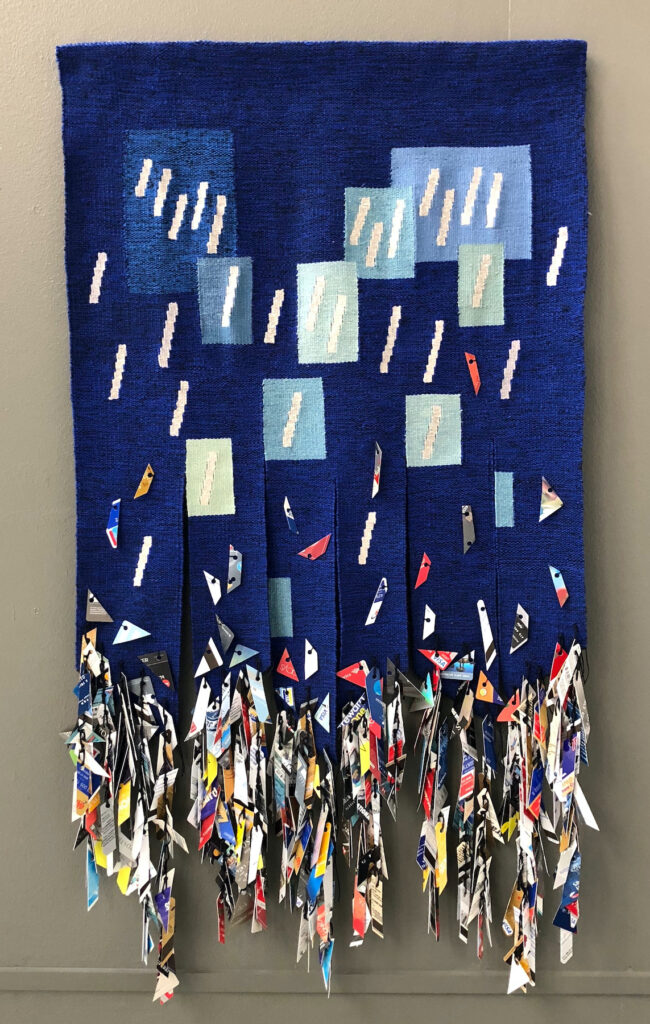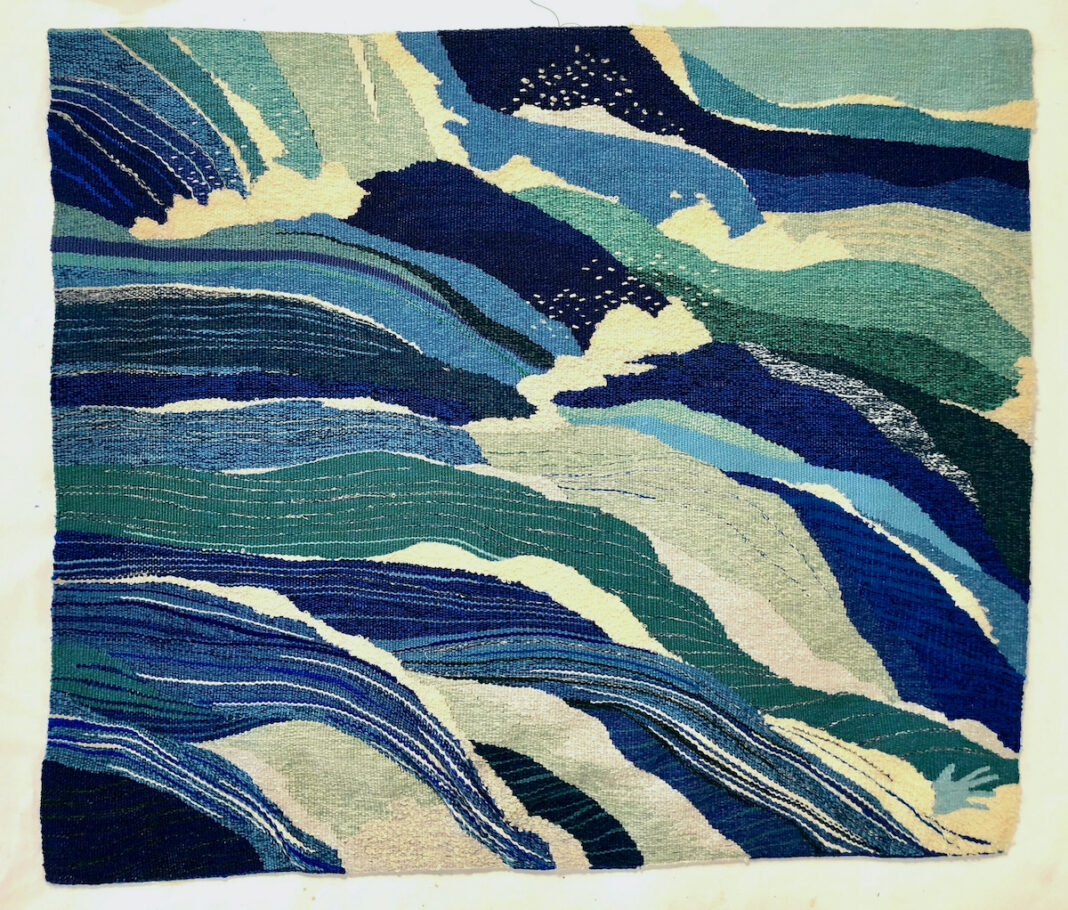If you ever want to have your mind blown, spend a day visiting ICB Artists Association in Sausalito. This once naval ship mold loft turned art collective houses over 100 artists of a variety of mediums. It’s a tremendously inspiring space, and the views out any window are jaw-dropping.
One such inspiring artist can be found on the second floor, studio 205. Alex Friedman is a tapestry weaver, rendering works in fabric that delight the eye, titillate the imagination and inspire a multitude of questions, the main one of which is, essentially, how does weaving work?
A great question.
I visited Friedman’s studio on Saturday of last week and watched her process a bit, endeavoring to understand how such fabric masterpieces are constructed. She graciously gave me a demonstration of her process.
In order to create her works, Friedman deftly weaves strings, in a multitude of colors, depending on her goal, back and forth across, well, other pieces of string. The first set of strings, running horizontally, create what’s called the weft, while the vertical strings, stretched taut between a wooden frame, create what’s called the warp.
The warp, Friedman explained, is like the skeleton of the tapestry. It must be taut, tight and made of strong material. The weft, by contrast, is like the body, and can be anything, really. Plastic bags, grass, yarn. It’s often varied in color and can be varied in material also.
When the tapestry is finished, Friedman cuts it off at the warp, with six or so inches extra, for knotting. This extra warp, when left exposed, is what creates the fringes on carpets—a fun piece of trivia to take to the upcoming Halloween party—but Friedman prefers, after creating a row of soumak knots which secure the tapestry, to fold her warp back at the knotted line, sewing it in place so the tapestry has no exposed warp edges. She sews to the folded warp a piece of velcro, which is used to hang the tapestry on the wall.
Friedman expertly and patiently explained this process to me a few times, which I understood eventually with the help of a self-constructed diagram on my office whiteboard. Weaving is an interesting combination of complicated and simple.
She has two main looms: a Glimakra rug loom and an eight foot Shannok tapestry loom, which she playfully refers to as the “big boy.” The Shannok, along with being bigger, has pedals, which Friedman can press to bring certain sections of the warp forward at a time, allowing her to build different patterns within the weft.
After weaving a few lines of the weft—the horizontal strings, in case it’s still confusing—through the desired strings of the warp— the verticals—Friedman used a fork to tamp them more securely in place. By way of a map, or blueprint, Friedman had a large sketch tacked up on the wall next to the Shannok, which she told me is called a “weaving cartoon.”
I found this interesting, thinking immediately of Bugs Bunny and Daffy Duck. In fact, the word cartoon, Friedman told me, is actually derived from the Italian word cartone, which means a drawing on strong paper, used as a model for another work. Another fun fact for the Halloween party.
It was all very satisfying: her foot pedaling to lift and lower the warp, her deft-fingered weaving of the weft, the fork-delivered tamping that punctuated the process every so often. I felt a sense of ancient history, present in Freidman’s colorful, light-filled studio, and my mind wandered to far off deserts, or castle halls, where men and women sat dying wool, spinning it to yarn, weaving such tapestries as The Apocalypse Tapestry from the 1300s, and the Unicorn Tapestries from the 1700s. If these names are unfamiliar, spend an enjoyable half hour on the internet—as I did—perusing BBC’s Top 10 Most Beautiful Tapestries.
Friedman’s story is as interesting as the process of weaving itself. Originally planning to pursue a career in architecture, she found herself after college at an architectural firm in Cambridge, MA. She spent her time cataloging everything from blueprints to doorknob samples, as well as model building. It became clear to her how incredibly difficult a career in architecture was, and how rare it was to make it into residential architecture, the field in which she was most interested. A change needed to be made.
“Someone said why don’t you try weaving?” said Freidman. “So I signed up for some weaving classes at Boston Y and fell totally in love with it, but had no idea how I was going to make a living. I just loved working with my hands, with the color, designing things.”
When her husband was transferred to New York City in the 1970s, Friedman joined a group of weavers and came across a woman who’d been commissioned by Pan Am Airways to make tapestries for their new fleet of 747 planes. Friedman went for an interview and was hired.
“I’d never made a tapestry before! But I brought along all the shawls and pillows and blankets I’d made.”
Each 747 needed six tapestries: four that went across the bulkhead of the first class cabin and two more that covered the movie screens, for a total of 216 tapestries that Friedman and her four fellow weavers produced in a building in Manhattan’s Garment District.
“There was no head and no AC in the building, and concrete floors. But it was such good times, and comradery. And we managed, you know. Mittens in the cold, and we’d strip down in the hot weather.”
After finishing that project and staying on with her commissioner for another year to complete various others, Friedman and her husband moved to England, where she started up her own work full time.
“I was already doing my own work—I would come home from weaving during the day and weave into the night. I had a big frame loom at that time. Going to England was good because I really had to cut my support group and start on my own.”
After three years in England, Friedman and her family moved back, settling in Connecticut, where she bought her first large scale loom when her daughter entered kindergarten. And it worked. She was able to sell her work, and made weaving her full time job.
“I knew I was never going to get rich, but I could make my work, and it paid for itself.”
She started with very realistic-style tapestries, commissioned by offices and corporations. The works, which can be explored on her website, are truly beautiful—they have an almost David Hockney-like quality in both their subject matter and their sense of tone: sunglasses and a book sitting on a back stair, three peaches in a window in front of which beach towels hang. The tapestries feel dimensional, quiet, real.
In the early 2000s, Friedman broke out of representational subject matter and into abstract work. Her explorations in texture and color have resulted in a varied and intriguing body of work, including Discharge, a one-off piece she did in response to her growing awareness of the trash production in America.
“I had all these leftover credit cards that I’d never thrown away because they seemed to be such good pieces of plastic. So I cut them all up into little pieces, punched holes in them, and wove them into a tapestry I call Discharge, that represents consumption and over consumption, and in particular our litter making its way into the oceans. I combined those elements in this piece.”

The result is striking, and a wonderful example of how artists can create beauty and social commentary simultaneously—making it much easier to ingest.
Friedman’s work sparked a passion for weaving in me I didn’t know existed. Something about working with the hands in such a way reminds me of scarves I used to knit as a pre-teen. I never moved past the scarf or onto the loom, but who knows? This might be the moment.
Perhaps there’s a weaver in all of us, an ancient remembering in our DNA, like building a fire or gathering together to tell stories. Regardless, there’s certainly one in Alex Friedman, and her work is well worth the visit.
Meet Friedman and see her work for yourself—along with the resplendence that is ICB—Oct. 15 from 11am-5pm. www.icbartists.com












Seriously fantastic review of Alex Friedman’s gorgeous, complex work, but also an incredible tapesty of words you’ve created here. So beautiful.
Thank you so much, Leslie!
This work sounds truly inspirational and your rendering of the process is exquisite! If you or any of your readers would like to explore weaving in more depth you should definitely check out Full Circle Fiber Studio in Petaluma for lessons, or if you are ever down in San Anselmo I’d love to show you some stuff here at Meinolf Weaving School! Weaving is truly great.
Thank you for these kind words and great weaving suggestions, Travis!